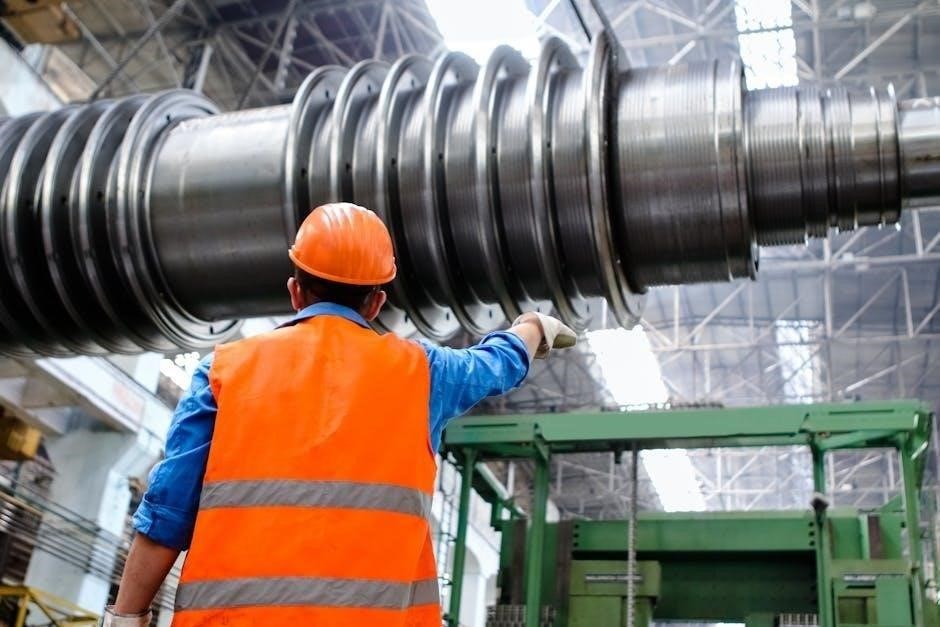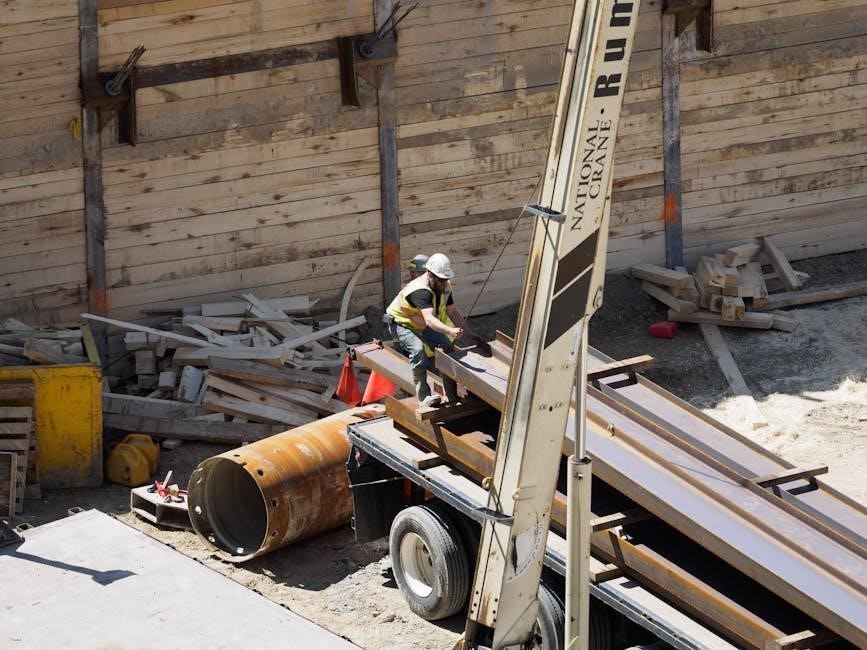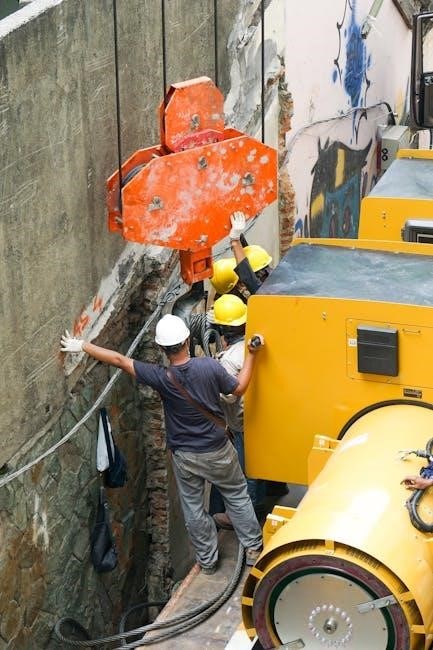Manual Crane Overview
Manual cranes are a fundamental type of lifting equipment, relying on human power to raise and lower loads. These cranes are particularly useful in settings where loads are relatively light and lifting tasks occur infrequently.

Types of Manual Cranes
Manual cranes come in various forms, each suited for specific applications. Common types include chain hoists, known for their durability; wire rope hoists, offering precise control; and jib cranes, which provide versatile lifting solutions within a limited area.
Chain Hoists
Chain hoists are a robust type of manual crane, utilizing a chain as the lifting medium. They are known for their durability and ability to handle heavy loads within their specified capacity. Chain hoists operate through a gear system, multiplying the applied force to lift substantial weights with relative ease.
These hoists are commonly employed in workshops, construction sites, and maintenance facilities where reliable vertical lifting is required. Their simple design makes them relatively easy to maintain and operate, even in demanding environments. Chain hoists offer a cost-effective solution for lifting tasks that don’t require high speed or powered assistance.
They are particularly advantageous in situations where electricity is unavailable or impractical. The manual operation provides precise control over the lifting process, allowing for careful positioning of loads. However, it’s important to note that the lifting speed is limited by the operator’s manual effort.
Wire Rope Hoists
Wire rope hoists, another type of manual crane, utilize a wire rope or cable as the lifting medium. These hoists are often preferred when a longer lifting distance is required, as wire rope can be manufactured in greater lengths compared to chains. Wire rope hoists typically offer a smoother lifting action than chain hoists, making them suitable for more delicate or precise lifting applications.
The construction of a wire rope hoist involves a drum around which the wire rope is wound. A geared mechanism allows the operator to rotate the drum, raising or lowering the load attached to the wire rope. Wire rope hoists are commonly found in environments where a combination of lifting height and smooth operation is essential.
Regular inspection of the wire rope is crucial to ensure its integrity and prevent potential failures. While wire rope offers flexibility and length advantages, it can be more susceptible to wear and tear than chains, particularly in harsh environments.
Jib Cranes
Jib cranes are a distinct type of manual crane characterized by a horizontal beam, or jib, that supports a movable hoist. The jib is typically mounted on a vertical column or wall, allowing for a circular or semi-circular lifting area. Manual jib cranes are particularly well-suited for localized lifting tasks within a workstation or production area. Their design allows for easy positioning of the load, making them efficient for repetitive operations.
One of the key advantages of a manual jib crane is its versatility. It can be easily installed and relocated, making it adaptable to changing workspace requirements. Jib cranes are often used in conjunction with chain or wire rope hoists to provide a complete lifting solution.
While jib cranes offer excellent maneuverability within their designated area, their lifting capacity is generally lower compared to overhead cranes. They are best suited for lighter loads and shorter lifting distances, making them ideal for tasks such as loading and unloading materials from machinery or assisting in assembly processes.

Advantages of Manual Cranes
Manual cranes offer several benefits, including cost-effective installation, versatility, and suitability for infrequent lifting. Their simple design translates to lower upfront costs and reduced maintenance requirements, particularly when compared to motorized crane systems.
Cost-Effective Installation
Manual cranes present a significantly more affordable installation option compared to their powered counterparts. The absence of complex electrical wiring, motors, and control systems streamlines the setup process, reducing both labor and material expenses.
Because manual cranes are simpler, fewer specialized technicians are needed for their initial setup, further contributing to cost savings. This ease of installation makes them an attractive choice for smaller workshops, garages, or locations where a permanent, high-capacity lifting solution isn’t required.
The reduced complexity also minimizes the need for extensive site preparation, such as reinforcing structures to accommodate heavy machinery. This can be particularly beneficial in existing buildings or spaces with limited structural capacity.
Furthermore, the lower initial investment allows businesses to allocate resources to other critical areas, enhancing overall operational efficiency. This cost-effectiveness makes manual cranes a smart choice for budget-conscious operations.
Versatility
Manual cranes exhibit remarkable versatility, adapting to various lifting needs across diverse environments. Their simple design allows for easy customization and adaptation to specific tasks. Unlike fixed overhead cranes, manual jib cranes offer a wide range of motion, enabling operators to lift and move objects within a defined radius, proving invaluable in machine shops and assembly lines.
Their portability makes them suitable for temporary job sites or locations lacking permanent infrastructure. Manual cranes can be easily disassembled, transported, and reassembled as needed, providing flexibility in dynamic work environments.
The ability to operate without electricity makes them ideal for remote locations or areas where power sources are unreliable. This makes them invaluable for fieldwork, construction sites, and maintenance operations in challenging environments.
Moreover, the precise control offered by manual operation is advantageous for delicate tasks requiring careful positioning and handling of materials. This level of control is particularly useful in industries dealing with fragile or sensitive items.
Suitable for Infrequent Lifting
Manual cranes are exceptionally well-suited for scenarios involving infrequent lifting tasks. Their cost-effectiveness and minimal maintenance requirements make them an ideal choice for businesses or individuals who do not require frequent or heavy lifting capabilities. Unlike electric or hydraulic cranes, manual options don’t incur ongoing energy costs or demand complex maintenance schedules.
For workshops, garages, or small-scale operations where lifting needs arise sporadically, a manual crane provides a reliable and readily available solution. These cranes are easily operated by a single worker, simplifying the lifting process without requiring extensive training or specialized skills.
Furthermore, manual cranes excel in situations where precision and control are paramount, as they offer a direct and tactile connection to the lifting process. This manual control is particularly useful for delicate tasks or when maneuvering loads in confined spaces. The immediate response and absence of electronic delays enhance the operator’s ability to position items with accuracy.
Therefore, for infrequent lifting requirements that emphasize cost-effectiveness and control, manual cranes are a practical and efficient choice.
Disadvantages of Manual Cranes
While manual cranes offer cost-effective and versatile lifting solutions, they have limitations. These disadvantages include lower lift capacity compared to powered cranes and slower movement, making them unsuitable for high-volume or heavy-duty lifting operations.
Lower Lift Capacity
Manual cranes, by their very nature, are limited in the weight they can handle. Unlike their powered counterparts, which can lift tons of material, manual cranes rely on the physical strength of the operator or a geared system that, while providing mechanical advantage, still has a finite capacity. This makes them unsuitable for tasks involving heavy loads commonly encountered in large-scale construction or industrial settings.
The exact lift capacity varies depending on the specific design and materials used in the crane’s construction. However, manual cranes are generally best suited for lifting lighter items within a workshop, warehouse, or maintenance environment. Attempting to exceed the rated load capacity poses a significant safety risk, potentially causing equipment failure and serious injury to personnel. Therefore, careful consideration of the load weight is crucial when deciding whether a manual crane is appropriate for the task at hand.
Slower Movement
One of the inherent limitations of manual cranes is the pace at which they can move loads. As they depend on human power or a hand-operated mechanism, the lifting and traversing speeds are considerably slower compared to electric or hydraulic cranes. This slower movement can impact productivity, particularly in operations that require frequent or rapid lifting cycles.
The time required to lift and position a load with a manual crane is directly proportional to the operator’s effort and the gearing ratio of the hoist. While geared systems provide mechanical advantage, increasing the lifting capacity, they also reduce the speed. Consequently, manual cranes are best suited for applications where speed is not a critical factor and where precision and controlled movements are more important. In fast-paced environments, the slower movement of manual cranes may become a bottleneck, hindering overall efficiency.

Applications of Manual Cranes
Manual cranes find versatile applications across various industries and settings where their unique advantages align with specific operational needs. In maintenance workshops, they are invaluable for lifting heavy machinery parts during repairs, offering precise control and eliminating the need for complex electrical connections. Construction sites with limited power access also benefit from manual cranes, employing them for lifting materials like bricks or scaffolding components.
Furthermore, manual cranes are commonly utilized in warehouses for occasional lifting tasks, such as moving inventory or loading smaller items onto trucks. Their cost-effectiveness and simple operation make them suitable for situations where lifting is infrequent and the load weight is manageable. Additionally, these cranes are used in agricultural settings for lifting equipment or produce, and in marine environments for boat maintenance and repair. The portability and ease of use of manual cranes ensure their continued relevance in diverse application scenarios.

Safety Considerations for Manual Crane Operation
Operating manual cranes safely requires strict adherence to safety protocols to mitigate potential hazards. Before any lifting operation, a thorough inspection of the crane’s components, including chains, hooks, and brakes, is crucial to identify any signs of wear or damage. Operators must be adequately trained on the crane’s operation, load limitations, and emergency procedures.
Load weight should never exceed the crane’s rated capacity, and the load must be properly secured to prevent slippage or imbalance during lifting. Clear communication between the operator and any assisting personnel is essential, utilizing hand signals to coordinate movements. The work area should be free of obstructions and personnel not involved in the lifting operation. Regular maintenance, including lubrication and adjustments, is vital to ensure the crane functions optimally and safely. Following these precautions minimizes risks and promotes a safe working environment.


0 Comments